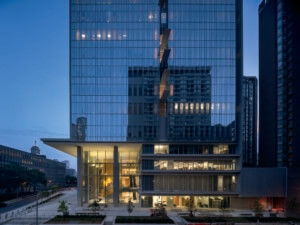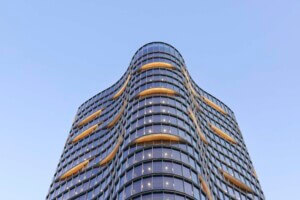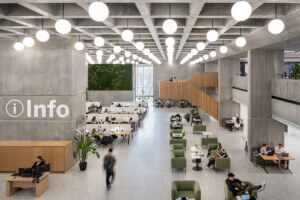Once marketed as “The City Above Toronto,” the City of Vaughan is considered to be one of the fastest growing suburban cities in the Greater Toronto Area. Their new five-year-old Civic Center campus is situated just outside the historic community of Maple, an agricultural center dating back to the mid-1800’s, and it’s commuter rail station linking the city to downtown Toronto. The upcoming Toronto-York Spadina Subway Extension—projected to open in 2018—along with a planned transit-oriented development that anticipates housing for 25,000 residents and employment for over 11,000 workers promises to establish a new identity for Vaughan. Nestled in between all of this is the City’s latest project: the Vaughan Civic Centre Resource Library. Designed by Toronto-based ZAS Architects, the building responds to a “library of the future” brief with a sweeping glass and steel “maker-space” dedicated to community learning, gathering, creating, and celebration.
Peter Duckworth-Pilkington, Principal at ZAS, says the library functions as a connective building between Vaughan’s City Hall, completed in 2011, and the historic town center of Maple. A sweeping roofline, which tapers from a monumental civic scale down to a smaller two-story height, establishes the massing of the library. “We used the metaphor of a tent: the idea that this was a large tent the community could come into and participate in community activities like author readings, maker-spaces for art and music, and other gathering spaces.” The facility is also located 2-miles away from Canada’s Wonderland, the county’s first (and largest) amusement park. Duckworth-Pilkington says this adjacency had an influence on the design. “The curve to the roof forms were inspired metaphorically by the flamboyant curves and edges of Canada’s Wonderland’s roller coasters.”
The structural and facade system was specifically designed to provide an engaging and transparent relationship to the city. A “V” configuration of primary steel columns produces a large-scale truss-like system that maintains open ground level with larger spanning members set up higher in the roof plenum. Set outboard of the steel frame is a curtain wall facade that dynamically curves, cants, and tapers.
A compositional grid, set at an angle, provides the basis for mullion and panel spacing. The panel sizes of 1500mm (roughly five feet) subdivide by halves and thirds tracking up the facade, helping to organize and visually break up the lengthy elevation.
- Facade Manufacturer
Noram Glass; Alumicor Limited; Ontario Panelization - Architects
ZAS Architects - Facade Installer
Noram (ACP & curtain wall glazing); Ontario Panelization (porcelain panels at main entrance) - Facade Consultants
n/a - Location
Vaughan, Ontario (Canada) - Date of Completion
2016 - System
curtain wall - Products
Alcotop (aluminum composite panel system); Alumicor (glazed aluminum curtain wall); Ontario Panelization (porcelain enamel faced panels)
The shapely box was designed utilizing three sets of software: Grasshopper provided the initial project geometry, a design model was developed in Rhino, and the working drawings were produced in Revit. From here, the model was further developed by the steel company to develop shop drawings. Once the primary steel frame was erected, curtain wall installers used a full 3_D scan of the frame to benchmark their shop drawings off of, to account for any construction tolerances deviating from the initial digital model.
About 60% of the facade is composed of glass, which features a custom-designed frit pattern developed in-house by the architects. The pattern transitions from large densely packed squares to a lighter array of dots, achieving a gradient effect that is responsive to viewing angles and solar orientation. “The frit was meant to dissolve the solidity of the metal panel into the transparency of the glass,” said Duckworth-Pilkington. The fritting also helps to deter bird strikes, a concern given the building’s park-like setting.
The canted facade incorporates an extended cap mullion detail that provides additional solar shading and places additional emphasis along one of the primary walkways leading to the main entrance. The facade material changes at the library entrance, which has been formally carved out of the box-like massing of the building. The ceramic panels set in a triangulated patterning create what Duckworth-Pilkington calls an “ice cream bar” effect of a hard chocolate shell on the outside, with an ice cream center.
The facility is designed to accommodate Maple’s library branch, a mere 8-minute walk away, and is set to officially open on September 10th, in coordination with a new council and new school year. The city has commissioned ZAS to design a new branch library about 10 minutes away from this location with a similar design brief. Designs have been completed on that project, which is currently out for bid.










